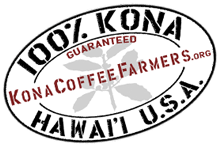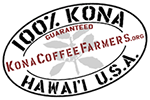“Best Agricultural Newsletter in Hawaii”
Newsletter of the Kona Coffee Farmers Association May 2018
PO Box 5436 Kailua Kona Hawaii 96745 USA
Contents
President’s Message
Vertical Selection Workshop
The United Nations & Kona Coffee
Coffee Quality Workshop
CTAHR – Rat Lung Worm Disease Prevention Video
Proposed Resolutions
EXPO 2018 Photos
Coffee Flowers of Different Varieties
Recipe: Coffee Mousse
Write to Us
Editor – Clare Wilson
President’s Message

KCFA Attendance at the Specialty Coffee Expo in Seattle
The SCA Expo is the single largest coffee trade show in the world. Previously known as SCAA, the Expo has now combined into a massive show that brings in thousands of growers, green buyers, vendors and scientists from around the globe. This year, KCFA sent a representative to see how the show has grown and to consider whether to be more actively involved in the future.
The SCA show is divided up into different segments. Purchasing a “floor pass” gets you access to 3 days of lectures, hundreds of vendor booths, coffee cuppings, a dizzying array of activities and local roastery tours. For the truly committed, there are add-on trainings and the Re:Co symposium (Think TED Talks for coffee). It would benefit almost every farmer to go at least once.
While there, I took many notes and will try to spin out more newsletter articles on the lectures I attended. I believe KCFA has a place at such an event. Kona is represented at the show through the Hawaii Coffee Association booth. However, HCA focuses on a balance of coffee from around the islands and does not specifically promote Kona in a way that could benefit our growers. Perhaps it’s time for us to consider carrying the flag again, and promoting our heritage crop to the world through SCA.
–submitted by Suzanne Shriner
KCFA Presents Vertical Selection Workshop

Which 3 or 4??????
WHEN: Saturday- May 19, 2018 (9:00-11:00 am)
WHERE: Bob Nelson & Bob Smith, at Bob Nelsons’ Farm located makai of the Kona Joe sign in Kainaliu, along Mamalahoa Highway. Drive down; parking available on right.
WHY: Choose the best vertical/shoots from among the new growth following the pruning completed a few months ago. Select vigorous shoots to insure high yielding verticals for the crop in 3 years.
FREE for KCFA members and $10 (applied towards membership) for non-members.
–Submitted by Cecelia Smith
The United Nations and Kona Coffee
The United Nations Examines “Kona Coffee” as a Geographical Indication
The Food and Agriculture Organization (FAO) of the United Nations has recently released a 158 -Page publication entitled, “Strengthening Sustainable Food Systems Through Geographical Indications”. Here is the LINK to the publication: http://www.fao.org/3/I8737EN/i8737en.pdf
For those concerned about protecting regionally identified agricultural products, review of the entire publication is important. There is an “Executive Summary” for the broader FAO publication at pages xi-xviii. A “must read” for KCFA members is the separate section (pages 83-90) on Kona Coffee.
The following items of interest from the Executive Summary have been noted by Cecelia Smith:
Page xi Executive Summary of Study-“…A specific methodological framework (detailed in the annex) has been developed based on qualitative and quantitative analysis of each case thanks to field work carried out by Masters and PhD students, so as to identify the economic impacts of GI processes and define the mechanisms involved…”
Page xii Positive influence on production, especially in the long term“…Mature GIs, where long-term impacts can be observed, show that promoting a GI increases production over time. This is particularly clear for Kona coffee, which sees a 250 percent increase between 1995 and 2015, and 36 percent more producers between 1991 and 2012;…”
Page xiii KEY success factors
Specific quality for differentiation and adding value
“The specific qualities that origin can provide emerge clearly as a pathway to positive economic impacts. This correlation between the quality defined in the specifications and economic impacts is based on various mechanisms… Kona coffee producers, on the other hand, have no agreement regarding the rules for using the GI – and this puts the reputation at risk in the long term.
The following items of interest from the separate section of the publication on Kona Coffee have been noted by Bruce Corker:
Page 83 “Key Messages” section—(1) “Most Kona coffee [that is, coffee using the “Kona” name on the label] is sold in the form of a blend of Kona coffee and foreign coffee”; and (2) “Protection of the name [of Kona coffee] is not effective since controls are not carried out for lack of financial resources.”
Page 89 “Conclusions and Future Outlook” section—This coffee [Kona coffee], with its unique typicality and a market with a major high-added-value demand does not enjoy any strong protection of its name, leaving the downstream stakeholders [and not farmers] to reap the economic benefits of the fame of Kona.”
Page 90- An important reference noted in the Kona Coffee section of the publication is the Marvin Feldman study, “Economic Effects of Blending Kona Coffee”—a study initiated and funded by the Kona Coffee Farmers Association. To read the Feldman study, click HERE.
–Submitted by Cecelia Smith & Bruce Corker
Coffee Quality Workshop
UH-CTAHR’s Cooperative Extension and the HCA invite you to participate in a “Coffee Quality Workshop. This workshop will provide detailed information on how quality coffee producers create high-scoring coffee. Specific techniques will be tied to cupping point increases so that farmers can choose the techniques they wish to use.
Participants will learn strategies on how to prepare for coffee cupping competitions and auctions, including steps from farm level through to storage that will help make them a competitive entrant. There will also be discussions of how points are gained and lost in cupping coffee. The workshop will cover growing, picking, processing and storing high-point coffee. In addition, workshop participants will learn how to successfully execute a variety of processing methods: Washed, Natural, Honey, and the risks and potential rewards with each.
The workshop is May 29, costs $25 and growers can register here: https://www.hawaiicoffeeed.com/coffee-quality-workshop—kona.html
–Submitted by Suzanne Shriner
CTAHR – Rat Lung Worm Disease Prevention Video
The CTAHR Farm Food Safety Team, in collaboration with Hawai‘i State Departments of Health and Agriculture, has released a new video on Rat Lung Worm (RLW) disease prevention. It describes common slugs and snails found in Hawai‘i that may carry the parasite, explains how to find them in the garden and what sort of conditions they like, and gives tips on how to make the environment less appealing for them.
Some things to do include cutting back vegetation so the pests have less places to hide, creating raised beds, and not leaving pet food out overnight. It also describes methods of deterring, trapping, physically removing, and killing slugs and snails. This is a potentially scary disease, but this video offers practical and down-to-earth advice that can help.
video : Rat Lungworm Disease Awareness YOUTUBE.COM
Proposed Resolutions
The Hawaii County Democratic Convention was held on April 28. Bruce Corker proposed the following resolutions, all of which were accepted.
2018-02 Calling for the Hawai’i State Legislative Committee Chairs of the Democratic Party of Hawai’i to be Held Accountable
2018-03 Calling for Truthful Labeling of Hawai’i-Grown Coffee and for Related Purposes
2018-04 Urging the State Legislature to Implement a Video Conference System for Facilitating State Legislative Testimony from the Neighbor Islands, Including East and West Hawai’i Island
–Submitted by Kay Dixon
Photos from KCFA EXPO 2018


HDOA Chair Scott Enright CTAHR’s Booth
Coffee Flowers of Different Varieties
An interesting display of coffee flowers for different varieties of coffee

–Submitted by Chris Coleman
Recipes Wanted! If any of you have coffee recipes that you would like to share, please submit them to the editor: clare@huahuafarm.com
Recipe: Coffee Mousse
Ingredients:
2 cups evaporated milk
2/3 cup strong coffee
2/3 cup brown sugar
3 egg yolks
1 envelope unflavored gelatin, softened in 3 tablespoons cold water
1½ cups heavy cream
In a medium saucepan, combine the evaporated milk and coffee; cook over low heat, stirring occasionally, until it just starts steaming. In a separate bowl, whisk together the egg yolks and brown sugar.
Add ½ cup of the hot milk to the egg mixture, whisking constantly, until the mixture is thoroughly combined. Add the warm egg-milk blend back into the hot milk in the saucepan and cook over low heat, stirring constantly, until the mixture reaches 165 degrees on a digital candy thermometer.
Remove from the heat and stir in the softened gelatin. Chill the coffee custard thoroughly.
Beat the 1½ cups of cream in a separate bowl until stiff peaks form. Thoroughly stir ½ cup of the whipped cream into the chilled custard, and then gently fold in the remaining cream. The coffee mousse is ready when the custard is thoroughly incorporated into the whipped cream, and no marbling shows. Serve the mousse chilled.
Serves 8
LET US KNOW WHAT YOU THINK! >> Write to us. We welcome Letters to the Editor up to 150 words. We reserve the right to edit for clarity and length. Include your name and email address >> Email: info@KonaCoffeeFarmers.org with SUBJECT: Commentary.



